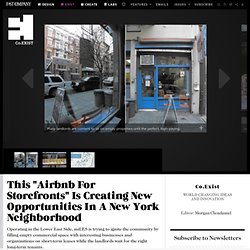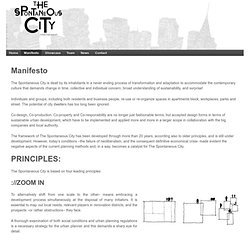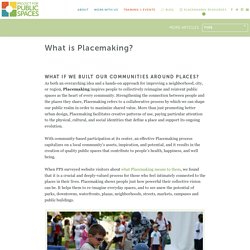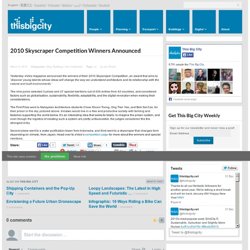

#Market time in San Pedro. #city #cities #market... Pedalling myths: the anti-bike lobby is flat out of plausible arguments. EBW_WALKING_REVOLUTION. 12 Fresh Ideas for Transforming the Places We Live With Open Data - Emily Badger. This year, the Knight News Challenge has been soliciting project proposals that would open up and leverage government data anywhere at the national, state and local levels (in the U.S. and abroad).

As of last week, 886 projects are vying for a share of the $5 million in funding, all in response to this question: "How can we make the places we live more awesome through data and technology? " Amid all of the submissions are some familiar innovations we've already encountered at Atlantic Cities, formerly as nascent ideas now competing for a chance to scale up: our favorite guerrilla wayfinding campaign from Raleigh, North Carolina; Code for America's playful StreetMix web app; the San Francisco-based Urban Prototyping Festival; and a community-driven transportation planning project based on the kind of data analytics we wrote about here.
This "Airbnb For Storefronts" Is Creating New Opportunities In A New York Neighborhood. Despite its rapid gentrification over the past decade, New York City’s Lower East Side is still surprisingly full of vacant storefronts, as many as 200.

According to Eric Ho, an architect and founder of neighborhood revitalization group miLES (Made in the Lower East Side), that’s because many landlords are content to sit on empty properties until the perfect, high-paying, long-term tenant comes along to sign a lease. The result is a constellation of unoccupied spaces that add little value to neighborhood residents, business-owners, and visitors. MiLES’s mission is to activate those storefronts, by matching up vacant units with temporary tenants, including entrepreneurs who might want a space to run a pop-up shop or education and community focused organizations looking for affordable meeting space.
Connecting Urban Explorers. Could Coconuts Purify Urban Water Supplies? This post is also available in: Chinese (Traditional), Italian, Farsi By Kyla Mandel at Green Futures The humble coconut can offer a quick-fix for the thirsty, but could it also provide a reliable source of clean water?

Why Urbanista.org? The Spontaneous City International. Manifesto The Spontaneous City is dealt by its inhabitants in a never ending process of transformation and adaptation to accommodate the contemporary culture that demands change in time, collective and individual concern, broad understanding of sustainability, and surprise!

Individuals and groups, including both residents and business people, re-use or re-organize spaces in apartments block, workplaces, parks and street. The potential of city dwellers has too long been ignored. Co-design, Co-production, Co-property and Co-responsibility are no longer just fashionable terms, but accepted design forms in terms of sustainable urban development, which have to be implemented and applied more and more in a larger scope in collaboration with the big companies and local authority.
Challenges and Warts: How Physical Places Define Local Economies. Is this Placemaking?

Some would say yes… / Photo: Brendan Crain. ‘Do not base policies about cycling on the views of existing committed cyclists’ Some of you will no doubt remember the advice – quoted in the headline of this post – of the 2011 Understanding Walking and Cycling Report [pdf]. do not base policies about cycling on the views and experiences of existing committed cyclists.

These are a minority who have, against all the odds, successfully negotiated a hostile urban environment to incorporate cycling into their everyday routines. It is necessary to talk – as we have done – to non-cyclists, potential cyclists, former cyclists, and recreational cyclists to determine what would encourage them to make more use of this transport mode. The Report investigated the barriers to cycling (and also to walking) in Great Britain.
Welcome to the Flaneur Society. The Flaneur Society was created in response to Walter Benjamin's book Berlin Childhood Around 1900.

In it he explores the concept of the Flaneur, one who wanders without destination. Intrigued by this concept, the society was created to spread the concept of the Flaneur beyond academic studies and into the general consciousness of how we think of urban spaces. Citizen Powered Change. How it Works. The Public Realm Creates the City. It would not be unfair to characterize the growth we are experiencing as “astronomical,” even in light of the current, apparent, slow down.

Some believe we are experiencing a seismic shift; the very fabric of the city is being redefined with every newly approved application, and it’s tempting to question whether the “centre will hold.” I was at a conference recently in the American Midwest where Toronto was identified as “the fastest growing city in the world,” and the comment rang in my ears. We cultivate livability. What is Placemaking? What if we built our communities around places?

Stats about all US cities - real estate, relocation info, crime, house prices, cost of living, races, home value estimator, recent sales, income, photos, schools, maps, weather, neighborhoods, and more. Green Roof Blocks - Simple Solutions to Building Green! This Big City - ideas for sustainable cities. March 9, 2010 by Joe Peach Yesterday, eVolo magazine announced the winners of their 2010 Skyscraper Competition, an award that aims to ‘discover young talents whose ideas will change the way we understand architecture and its relationship with the natural and built environments.’

Cyclists and Pedestrians Can End Up Spending More Each Month Than Drivers - Commute. Kelly Clifton has heard this stereotype a number of times: "Cyclists are just a bunch of kids who don’t have any money," says the professor of civil and environmental engineering at Portland State University. "They ride their bikes to a coffee shop, they sit there for four hours with their Macintoshes, they’re not really spending any money. " If you’re a shopkeeper with such suspicions, you’re probably not on board with any plan that would cut down on parking right outside your door. Cyclists are the ones with time to kill; drivers are the ones with money. This perception is problematic in a place like Portland, where the bike-friendly city government is now looking to extend the reach of bike infrastructure – and the appeal of bikes themselves – to newer riders and neighborhoods farther afield from the urban core.
The WaterTank Project. A grocery store for the people planned for West Oakland food desert. Brahm Ahmadi spends a lot of time thinking about something most people take for granted: grocery stores. But it hasn’t always been this way. As one of the founders of the nonprofit People’s Grocery in West Oakland — the Bay Area’s most notorious food desert — he and his colleagues started out with more affordable, less ambitious projects, like a mobile food delivery service and a local community-supported agriculture (CSA) box.
But it quickly became clear — as several grocery chains tried to enter the neighborhood and failed, and residents were left relying on corner stores or taking long trips by public transportation to other neighborhoods — that the area needed a reliable, independent grocery store. Is Free Rent Enough to Jumpstart a Sleepy Commercial District? - Neighborhoods. For decades, about five blocks of the South Avondale neighborhood of Birmingham, Alabama, was all but vacant. Once a small, thriving cultural district on the border of affluent sections of the city's Southside, South Avondale's business district had experienced a stunning decline in recent decades thanks to "white flight," population loss, and the closing of industrial businesses that manufactured goods such as cotton and bricks.
A 2010 photo shows construction at the building that's now home to the Avondale Brewing Company, via Flickr user Dystopos So when stimulus money became available for "shovel ready" projects in Birmingham, residents and city leaders thought of South Avondale's business district. Out of more than $20 million in federal stimulus bonds allocated for streets and park renovations in Birmingham, $3 million was put toward expanding a Central Park-modeled public recreation area on the land where the zoo once sat. The Limits of Density - Neighborhoods. Density is all the rage these days. Urban economists, some of whom could be heard extolling the praises of "sun, skills, and sprawl" just a few years ago, now see increasing density as the key to improving productivity and driving economic growth. In his story for The Atlantic, "How Skyscrapers Can Save the City," Harvard University’s Edward Glaeser put it this way: "As America struggles to regain its economic footing, we would do well to remember that dense cities are also far more productive than suburbs, and offer better-paying jobs ... tall buildings enable the human interactions that are at the heart of economic innovation, and of progress itself.
" What Are the 7 Keys to a Strong Community? - Neighborhoods. Ontario's Environmental WatchdogOntario's Environmental Watchdog. Commissioner’s Remarks to the Green Infrastructure Ontario Coalition Launch: November 22, 2010, Evergreen Brick Works, Toronto So what is green infrastructure? Green Infrastructure Ontario Coalition. The Strong Neighbourhoods Task Force - the United Way of Greater Toronto and the City of Toronto. ANC - Home. Action for Neighbourhood Change (ANC) was a unique learning initiative that explored and assessed approaches to locally-driven neighbourhood revitalization that can enhance the capacity of individuals and families to build and sustain strong, healthy communities.
Working with local residents, not-for-profit agencies and public and private sector partners, ANC combined local resources in new ways to develop creative locally-based solutions for sustainable community development and neighbourhood revitalization.
Bee keeping. Toronto. Vanishing Point. Spacing. Why We Pay More for Walkable Neighborhoods - Jobs & Economy. Get Your Walk Score - Find Walkable Apartments and Rentals. Now Coveted - A Walkable, Convenient Place. Walkability. The Stunning Geography of Incarceration - Design. TXTilecity. OBlog: Design Observer.